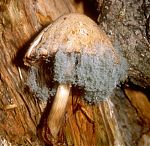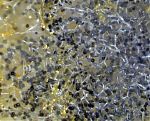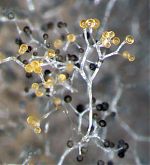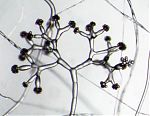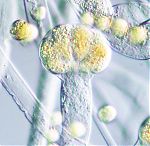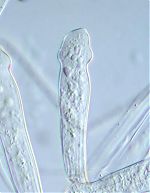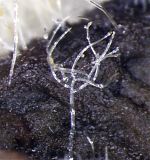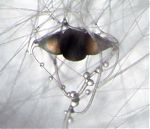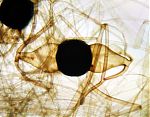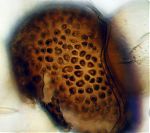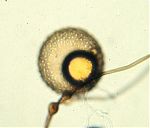Syzygites
SYZYGITES Ehrenberg: Fr., 1832 [Syst. Mykol. 3:329; nomen conserv., Art. 13.1(d) of the ICBN (Greuter et al., 2000; see Korf, 1982, 1983)]. (Hesseltine, 1957—monograph; Benny and O’Donnell, 1978—illus.; O’Donnell, 1979—illus.; Ekpo and Young, 1979—illus.).
≡ Syzygites Ehrenberg, 1818 ( Sylvae Mycol. Berol., p. 25).
= Sporodinia Link, 1824 ( Spec. Plant. 6(1):94).
≡ Sporodinia Link ex Wallroth, 1833 ( Flora Crypt. Germ. 2: 317).
= Azygites Moug. & Fr.: Fr., 1832 ( Syst. Mycol. 3:330), nomen conserv., Art. 13.1(d) of the ICBN (Greuter et al., 2000; see Korf, 1982, 1983).
≡ Azygites Moug. & Fr., 1825 ( Syst. Orb. Veg. 1:364).
Syzygites sporangiophores arise directly from the substrate. They are several times dichotomously branched with each branch terminating in a sporangium that is globose, columellate, and few-spored; wall deliquescent. Sporangiospores globose, with a spinose wall. Zygospores with a pigmented, ornamented wall; formed on a more or less equal, opposed suspensors. Zygospores formed on dichotomously branched zygophores terminating in sterile spines (Hesseltine, 1957).
Type species: S. megalocarpus
Species of Syzygites:
S. megalocarpus Ehrenberg: Fries, 1832 ( Syst. Mycol. 3:329).
In nature S. megalocarpus is parasitic on Basidiomycetes and a few Ascomycetes (Kovacs and Sundberg, 1999). Benny and O’Donnell (1978) described the ontogeny of sporangia, sporangiospores, and zygospores using light microscopy. The ontogeny of the zygosporogenesis, mainly using electron microscopy, in S. megalocarpus was presented by O’Donnell (1979). Syzygites megalocarpus is unusual in its formation of sporangiospores with spinose walls, a characteristic also shared by Sporodiniella umbellata (Ekpo and Young, 1979).
Syzygites can be grown in the laboratory on relatively nutrient-rich media. There has been some controversy regarding the environmental conditions that promote zygospore formation of Syzygites in culture (Kaplan and Goos, 1982). Davis (1967) induced zygospore production by growing S. megalocarpus at 10 C in continuous dark. More than 500 zygospores were produced in each Petri dish in cultures grown at 19 C on GYP medium with 0.2 M KCl regardless of the amount of light (Kaplan and Goos, 1982). Sparrow (1978) reports that the first incidence of sex in the fungi was observed in Syzygites.Bibliography
Benny, G.L., and K.L. O’Donnell. 1978. Syzygites megalocarpus, pp. 127-128. In: M.S. Fuller (Ed.). Lower fungi in the laboratory. Palfrey Contributions in Botany. No. 1. Department of Botany, University of Georgia, Athens, Georgia.
Davis, E.E. 1967. Zygospore formation in Syzygites megalocarpus. Can. J. Bot. 45:530-532.
Ekpo, E.J.A., and T.W.K. Young. 1979. Fine structure of the dormant and germinating sporangiospore of Syzygites megalocarpus (Mucorales) with notes on Sporodiniella umbellata. Microbios Letters 10:63-68.
Greuter, W., J. McNeill, F.M. Barrie, H.M. Burdet, V. Demoulin, T.S. Filgueiras, D.H. Nicolson, P.C. Silva, J.E. Skog, P. Trehane, N.J. Turland, and D.H. Hawksworth (Eds.). 2000. International code of botanical nomenclature ( St. Louis code ). Reg. veget. 138:1-474.
Hesseltine, C.W. 1957. The genus Syzygites (Mucoraceae). Lloydia 20:228-237.
Kaplan, J.D., and R.D. Goos. 1982. The effect of water potential on zygospore formation in Syzygites megalocarpus. Mycologia 74:684-686.
Korf, R. P. 1982. Citation of authors’ names and the typification of names of fungal taxa published between 1753 and 1832 under the changes in the Code of Nomenclature enacted in 1981. Mycologia 74:250-255.
Korf, R.P. 1983. Sanctioned epithets, sanctioned names, and cardinal principles in “: Pers.” and “: Fr.” citations. Mycotaxon 16:341-352.
Kovacs, R.L., and W.J. Sundberg. 1999. Syzygites megalocarpus (Mucorales, Zygomycetes) in Illinois. Trans. Illinois State Acad. Sci. 92:181-190.
O’Donnell, K.L. 1979. Zygomycetes in culture. Palfrey Contributions in Botany. No. 2. Department of Botany, University of Georgia, Athens, Georgia. 257 p.
Sparrow, F.K. 1978. Professor Anton DeBary. Mycologia 70:222-252.
Updated Oct 31, 2007

